- How radiator flush can prevent damage to your car engine
- How to flush the cooling system yourself
- How to choose the best radiator flush for your car
Ready? Let’s get started.
What is radiator flush?
A car radiator is an essential component. Its primary function is to keep the engine running cool. Radiators aren’t filled with just water, as many people assume, but specially designed coolant fluid.
Gradually, rust, dirt, scale deposits, clots, and other contaminants build-up within the radiator, and if left unchecked, they will damage your car engine. A radiator flush is a forced removal of these particles, contaminants, and blockages. Replacing the coolant fluid will then return the radiator to its efficient best. Professionals will often do it along with crucial vehicle servicing. This process is a stitch in time that prevents more prominent issues in the future.
Radiator flush necessity
Benefits of radiator flush
Remove scale deposits, rust and contaminants
Over time, rust, contaminants and scale deposits can cause blockages, which prevent the free flow of water and antifreeze through the car cooling system. Those contaminants cause overheating engines and can cause terminal damage to your car’s engine. A radiator flush’s formula can dissolve and dislodge the debris to return the cooling system to its efficient best.
Lubricate the water pump/better lubrication
The antifreeze not only keeps the engine temperature cool but also lubricates the engine water pump and bearings. The water pump and its bearings are important: they continuously pump and circulate coolant through the engine and cooling system—the additives in the coolant flush help to clear the water pump’s seals intact and leak-free.
Prevent future leak, foaming, corrosion, and debris build-up
Frequent radiator flushing prevents the build-up of debris and contaminants in your cooling engine. This is because you rid all pollutants in the cooling system with every proper flush. It keeps your radiator clean and at optimal function once a new coolant is refilled. When coolants stay too long in the engine, they turn acidic and start the oxidation process that creates corrosion. This includes all copper, aluminum, and steel. This wear causes rust and coolant leaks. Radiator flush and refill help reduce the possibility of wear, leakages, and rust.
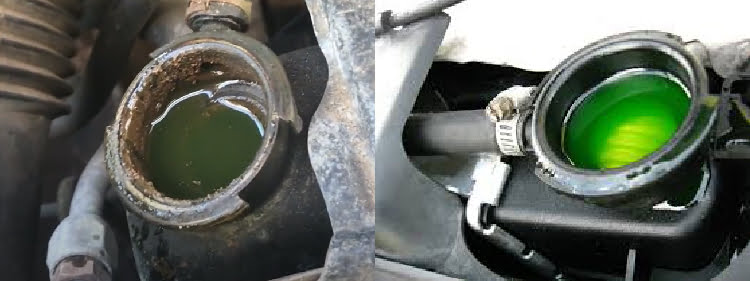
Consequences of not flushing radiator
Not flushing your radiator, or perhaps not flushing it properly, can lead to several problems:
Your car will give off strange smells
The smell is caused by bacteria growing and spreading through your car cooling system. A poorly maintained cooling system will also cause smoke to blow from your car engine and radiator from the car heating vents.
Your car’s engine will overheat
With time, rusts, scale deposits, and dirt collect and form large clots in the cooling system. Antifreeze most often turns into a sticky gel and blocks the radiator and water pump from not operating normally. If not flushed, the radiator’s internals will rust at a faster rate, the water pump and its bearings may seize, the hoses will crack and leak, and the engine will overheat and damage itself.
Extensive car damage and expensive repairs
At the early sign, you should flush your radiator. If you choose to ignore this, you may later have to spend even higher amounts on repairing your car. A radiator flush will cost you less than $100, while a seized water pump and replacement radiator can set you back several hundred dollars in repairs. If your radiator has leaked all its coolant fluid and your engine overheats and seizes, it is more than likely that you will need to rebuild your engine at thousands of dollars in repair costs.
Signs you need a coolant flush
Maintenance schedule
When did you last complete the radiator flush for your car? Regular maintenance is all your cooling system requires to operate at its efficient best. The maintenance schedule differs from one vehicle to another. Similarly, it depends on the type of coolant and active ingredients used for your car. There is a disparity of timing and mileage benchmark considered for each one. To be safe, it is advisable that you consult your car’s user manual
If you can’t remember when last your car radiator was flushed, is it probably due to being done then? Don’t hesitate to flush your car radiator.
Low coolant level
You can open the radiator top cap to see if the coolant fluid is low. Most modern cars have a low coolant warning light to indicate when the coolant needs to top up. If your coolant fluid is low, flush the system to check around the radiator for leaks. Top up the coolant fluid as indicated in your car’s owner’s manual.
Overheating and high-temperature gauge
Pay attention to your car instrument panel. If your car water temperature gauge reads hotter than normal, you need to inspect your cooling system. A frequently burning temperature gauge is a sign of much-needed radiator flush. If your engine is overheating and generating friction, but the radiator’s coolant level appears relatively full. It would be better if you flush the radiator before things get any worse
Smelling/smoking from the engine
Strong odors coming from your engine and radiator are the cause of bacteria in the coolant system. Smoke and steam rising from the engine bay in your car’s hood are signs that you need to flush your car’s radiator as the cooling system isn’t working properly.
Another sign that you need to pay attention to is a “sweet smell“. This sweet smell is caused by the coolant leak dripping onto hot engine parts. This means that the antifreeze is burning and your vehicle needs a flush as soon as possible
Leaking coolant or fluids from the cooling system
One more sign indicates the need for an immediate radiator flush is coolant leaking underneath your car. A leak means the presence of unwanted substances causing leaks in the cooling system. You should consider getting a radiator flush to locate the leak and fix it with a sealant.
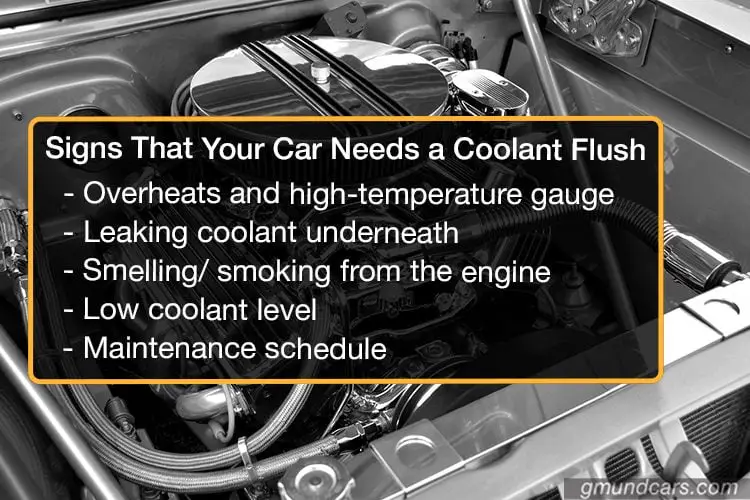
How often to flush the radiator
Consulting your owner’s manual for specific details. It should contain instructions and information about when and how you can attempt a radiator flush. If no signs prompt you to do a radiator flush, you should consider doing it every five years or every 100,000 miles driven.
However, if you drive in excessively cold or hot climates, you may need to flush your radiator fluid every 30,000 miles. Under those extremes, your car’s engine works hard and therefore the cooling system works even harder and it speeds up the process of the antifreeze becoming acidic and damaging your car’s engine.
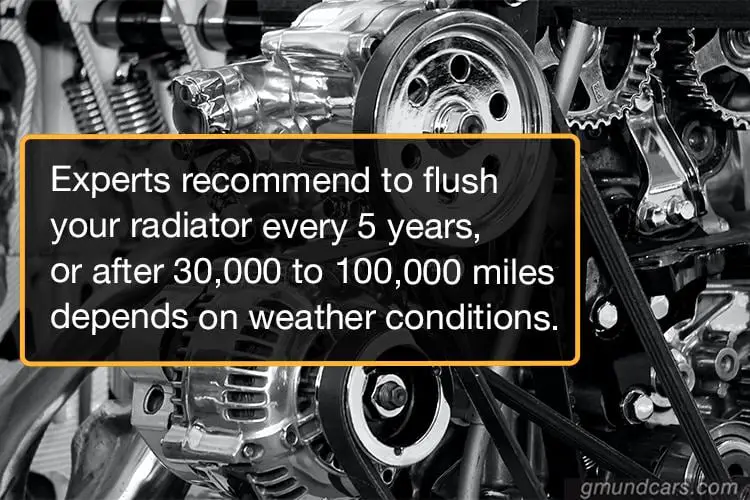
Let’s see some examples from car manufacturers’ instructions:
To Toyota cars, coolant flush must be done once every 30,000 miles or every 5 years, whichever comes first. The schedule for Hyundai should be 60,000 miles for the first change and every 30,000 miles after that. For Chevrolet, it is replaced at 150,000 miles, depending on how you drive your car…
How to flush the radiator
Preparation
Here’s what you’ll need to flush your radiator
- A car’s jack to lift up your car
- A flat pan to collect the old coolant
- Some gallons to store it for proper disposing or recycling, and a plier
- A pair of rubber gloves and safety glasses to protect yourself from volatile chemicals. More preferably, your clothes should be able to take stains.
- You can consider mixing your coolant and sealant fluids beforehand. Make sure to consult your user’s manual for the right type of coolant your vehicle uses.
Caution: Wait for about half an hour if you just finished driving. Make sure your radiator is cool. You can hold it with your hand comfortably. Opening your radiator while it’s hot will cause its fluid to spill.
Step-by-step guide
Step 1: Jack up your car
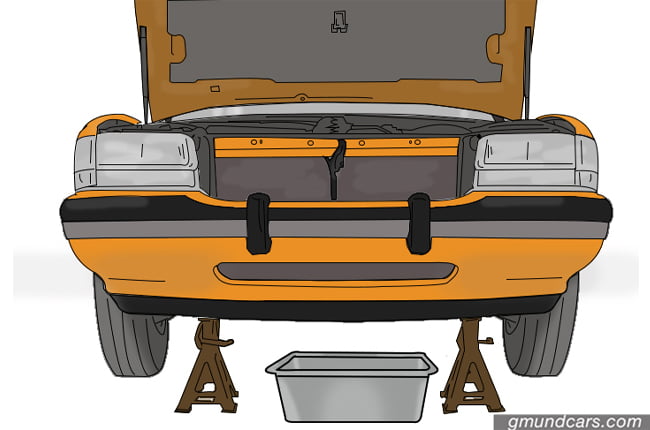
- Firstly, start by jacking your vehicle up several inches for better access to the underside. Position the jack under the metal frame, and not your car’s bumper.
- Place the bucket under the radiator’s drainage plug. A radiator usually holds about 2 gallons of fluid, so you must have a bucket large enough to hold that. Then locate the radiator’s drainage plug on the corners of the radiator frame’s underside.
Tip: The radiator drain plug is also called a drain petcock or drain valve. It is located at the bottom of the radiator that can directly drain the coolant. If there’s no plug, you’ll have to pull out a hose.
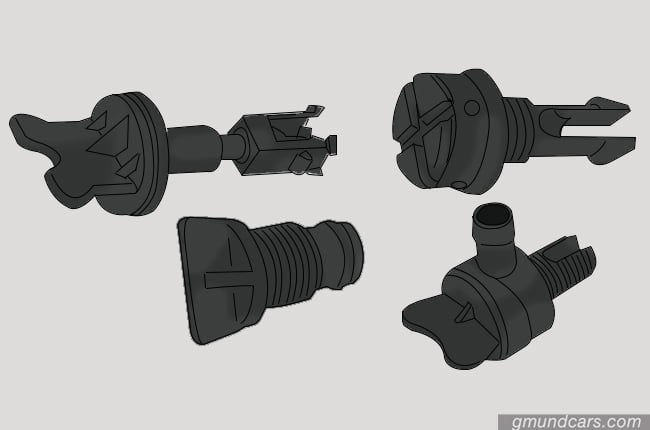
Step 2: Drain the old coolant
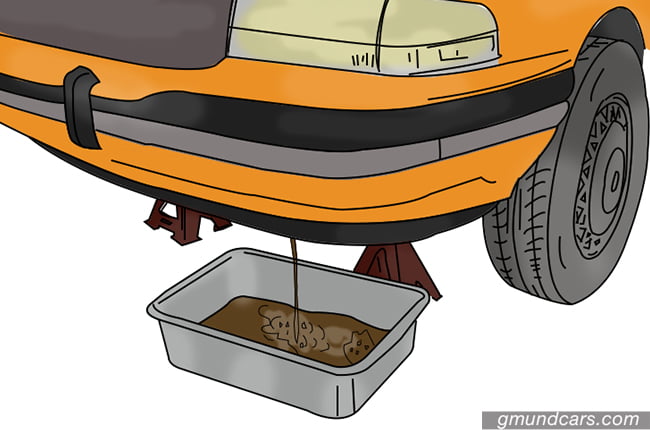
- Open the radiator pressure cap on the radiator’s frame top. This twist-off cap is where you will pour the new coolant fluid.
- Put the pan underneath and remove the drain valve with gloves and pliers. Allow the coolant in the radiator to drain into a pan. Turn on the engine to make sure everything in the system comes out completely. Then switch it off. You will see rust-colored or brown water running into the pan; that’s the contaminants and rust cleaned from inside your car’s cooling system.
- Then dispose the fluid properly because antifreeze is very hazardous and toxic.
Step 3: Pour flush cleaner into the radiator
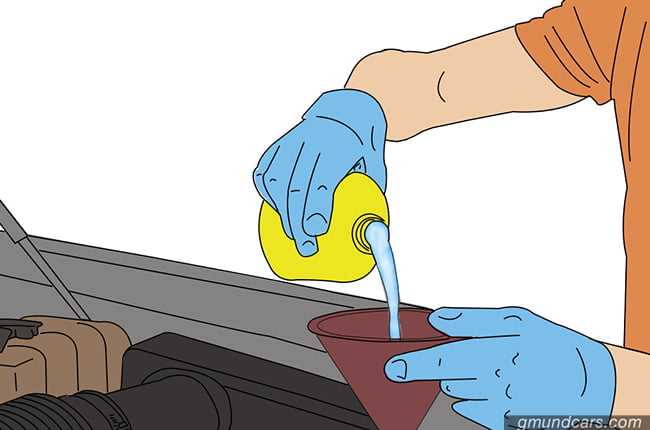
- It will take about 10 minutes to drain the coolant fluid completely. Once it has stopped dripping, replace the drainage plug. Use a funnel to slowly pour the mixture of distilled water and the flushing chemical into the top cap of the radiator. Until it is full, close the cap securely.
- Start your car’s engine to idle for 5 to 10 minutes so that the radiator flush can work its way through the engine’s cooling system to remove the contaminants.
Step 4: Drain the cleaner and flush the system again with distilled water
- Turn off the engine and wait until it is cool. Drain the radiator again as step 1.
- With the top cap and drainage plug still open, pour tap water through the radiator to flush it. Turn your car on again and pour 1 gallon of water into the radiator. Check the color of the water draining into the pan. Once it is clear, you can stop pouring tap water. Then, flush the radiator with 1 gallon of distilled water.
Step 5: Add new coolant
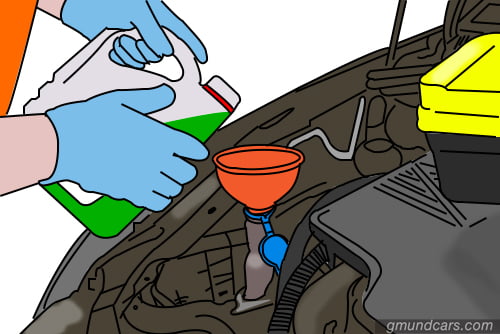
- Replace the drainage plug. Pour your coolant fluid into the radiator’s top cap. It is important to fill the radiator with the recommended amount of coolant fluid. Start your car’s engine to idle for 15 minutes.
Note: Check your manufacturer’s manual to know the right antifreeze and how much your vehicle needs.
- Turn the engine off and allow it to cool for 15 minutes. Open the pressure cap to see whether it has pulled the coolant fluid through the entire cooling system. If the coolant fluid has dropped to below the fill mark, you must add more solution. Slowly top it off and secure the pressure cap once again.
Radiator flush cost
Contracting a good mechanic’s services to run a simple radiator flush would cost you roughly an average of $100 and $200, depending on your car type. That is expensive! You can as well save $20 to $80 getting it done yourself. All you need to do is picking out an excellent coolant flush yourself, the best-suited antifreeze for your car specifications, some gallon of distilled water. Then, follow all the steps clearly outlined above.
A coolant flush and antifreeze of good quality could be bought between $15 and $60. It can easily be ordered from an online merchant store if you do not know a great shop to get one in the neighborhood.
Buying guide
Types of radiator flushes
- Liquid
The liquid radiator flush is the most commonly used in the market. It is less risky in applications than the powder radiator flush. To use it, all you need to do is pour in and drain with water. However, it is also caustic. It can become corrosive if in contact with skin. Therefore, it is advisable to use gloves during usage and to carefully ensure there is no spilling or splashing.
Liqui Moly 2051 Radiator Cleaner is one of the best liquid products available.
- Powder
The powder radiator flush, on the other hand, is less common for flushing radiator. It comes as dry and concentrated. Due to its level of concentration, it requires a dilute before usage or application. It is as effective as the liquid flush. You should wear gloves and a nose mask while using it. This is because it is quite easily inhalable and corrosive like the liquid solution.
Irontite Thoro-Flush is among the top powder-based radiator flush estimated by consumers.
Top brands
Thermocure
Thermocure is a sub-brand of Evapo-Rust, a company that concentrates on engine cooling systems and engine rust removal. When you see a product recognized by non-toxic and biodegradable formula, it is most likely made by Evapo-rust. This brand has become a top choice for many users since they make diverse products for almost all aspects of your car. One of their popular product in radiator flush is Thermocure Coolant System Rust Remover.

Prestone
Prestone is an American company specializing in automotive chemicals and lubricants. Its products range from radiator flush to stop-leaks, brake fluid, windscreen washing fluids, power steering fluids, and more. In radiator flush, their effective cleaning solution is suitable for most car owners. Hence, the Preston Super Radiator Flush proves the credibility of this brand with its many exciting features.

Irontite
Irontite is a brand with high-quality products designed and engineered for engine maintenance. Their range of products consists of Kwik-Way Valve Refacers; Irontite Additives; Van Norman Flywheel Grinders; and Irontite Diesel Tools. Their most popular product is Irontite Thoro Flush’s performance. It is second to none in the ability to put an end to rusts andcontaiminants in your cooling system.

Gunk Motor’s Niteo Motor Medic
Gunk is a family-operated company. It has established itself as a popular choice for many DIYers. This company has made fantastic and efficient auto products for 75 years. Basically, Gunk products are effective in removing oils and dirt from the cooling system. The most common product in coolant flush is Gunk C1412 10-Minute.

Liqui Moly
Liqui Moly is a German company that specialized in automotive lubricants, additives, and other chemicals. They offer different types of well-formulated products that are suitable for your automobiles. Liqui Moly Radiator Cleaner is one of the good choices among cleaner solutions on the market.

BlueDevil
This American company manufactures automotive sealants, additives, lubricants, and general vehicle maintenance. They distribute their lines of products across North and South America, Europe, Asia, and South Africa. Their most popular product in radiator flush is BlueDevil 00204

Other considerations
Other considerations to help choose radiator flush are the size and severity of the cooling system blockage; and the compatibility of the radiator flush for your car.
Blockage
Clearing your cooling system of contaminants, dirt, scale deposits, and rust, of blockages and clots takes time. A heavily clogged radiator will take longer to flush compared to one with minor blockage. Depending on the size and severity of the blockage in the system, you may need a stronger concentrate and formula. It may take more than one of two cycles to flush your radiator.
Compatibility
While manufacturers say that their products can work well on most vehicles, it is also important to check if your vehicle is compatible with the flush you’re using or not. Some radiator flushes aren’t designed to be used in cooling systems and radiators made of plastic, rubber, or certain types of metals. Some formulas are highly toxic and acidic, which could cause more damage. If you’re unsure about it, you must check with an expert before blindly following a recommendation off the internet.
Top 6 picks for the best radiator flush
Comparison table
| Type | Product Specs | Price | Verdict | |
|---|---|---|---|---|
| Thermocure TC001 | Liquid | Weight: 1 lbs Dimensions: 9 x 3 x 4 ins | $$ | Best for high-mileage and older vehicles - Biodegradable and non-corrosive formula - Work on metals, rubber, and plastic surfaces |
| Prestone AS105 | Liquid | Weight: 0.9 lbs Dimensions: 8 x 7.8 x 8.5 ins | $ | Best for heavy blockages - Ideal for both light flush and heavy duty cleaning of the cooling system - Safe to use on all engines, rubbers, plastics, and metals |
| Irontite THORO FLUSH | Powder | Weight: 1 lbs Dimensions: 9 x 3 x 4 ins | $$ | Best for heavy duty and old higher mileage vehicles - Powerful for clearing out coagulated grease, scales, and other possible blockages - Cleans out heater cores with ease |
| BlueDevil 00204 | Liquid | Weight: 2.74 lbs Dimensions: 8.5 x 5 x 2.5 ins | $$ | Best for deep cleaning - Work to clear water pumps, gaskets and to - Has the capability of reducing the failure probabilities of pumps, gaskets, and seals. - Removes all contaminants such as grease, rust, and grime |
| Gunk Motor Medic C1412 10-Minute | Liquid | Weight: 1.75 lbs Dimensions: 2.2 x 4.6 x 6.7 ins | $$ | Best for quick cleaning, low-maintenance - Takes just 10 minutes to flush the radiator - Free of harmful and toxic substances |
| Liqui Moly 2051 | Liquid | Weight: 12 lbs | $$ | Best overall - Suit all vehicles and is safe for all your engine’s rubber, plastic, and metal components. - Its formula neutralizes acids and alkalis that lead to rust forming on metals |
Thermocure TC001 – Best for high-mileage and older vehicles

Pros
- Biodegradable and non-corrosive formula
- Work on all metals, rubber, and plastic surfaces
- No pre-mixing require
Cons
- Produce unpleasant odors that may linger in your radiator after flushing
- Causes gelling and creates blockages if leave for longer than instructed
- Not compatible to be used with antifreeze
The first in our line-up is the Thermocure TC001 Cooling System Rust Remover Flush. Thermocure is formulated as a non-toxic and biodegradable radiator flush. Users of this flush praised it for effectively removing rust and scale deposits as it flushes through the cooling system.
It is found that this flush is best suited for older vehicles as this flush is developed to provide extra care and cleaning power to remove all the deeper and stubborn dirt. Thermocure does a good job to older cars because it can adjust the approach to flushing the radiator while not damaging the softer and aged metals and materials.
This product can be used for ATVs, Automobiles, Diesels, RVs, & Tractors.
Tips for usage
- This formula turns into a black liquid once it is flushed through your radiator. Pour water into radiator to remove the flush until water is clear to get the best result.
- After draining the current fluid in the radiator, add one quart of this product then fill with distill water. Drive your vehicle for 3-4 hours then remove extensive rust. Till the engine is cool completely, drain the system again.
Prestone AS105 – Best for heavy blockages

Pros
- It is a non-toxic and non-acidic formula
- It is safe to use on all engines, rubbers, plastics, and metals
- Heavy & light cleaning is possible depending on your requirement
- Unique formula with chelating ions
Cons
- Need to repeat cleaning cycle twice or more
- You may need more than one bottle for your heavy cleaning
This Prestone-developed radiator flush is specially designed to remove heavier blockages from your car’s cooling system. With super strong cleaning ingredients, they regard it in the industry as the “heavy duty” cleaner for all vehicle engine and radiator types.
Tips for usage
- If using this radiator flush in winter, don’t leave it in your car for longer than instructed as it will freeze
- Prestone recommends keeping the product in their system for a few days to ensure a heavy-duty cleaning. However, it can be used for light cleaning as well.
Irontite Thoro-Flush – Best for heavy-duty and old higher mileage vehicles

Pros
- Formulated for higher mileage vehicles where particle buildup is greatest
- Specially developed to remove old antifreeze, rust buildup, and blockages in just one cycle
- Cleans out heater cores with ease
Cons
- Not suitable for dissolving large blockages
- Can causes burns once in contact with skin (use gloves during diluting and process cooling
The Irontite Thoro-Flush is another heavy-duty cleaner. This one not only tackles rust and scale deposits, but is powerful enough to remove stop-leak radiator foams and gels.
This formula is best suited to older and higher mileage vehicles where rust, sludge, dirt, and contaminants collect easier and more difficult to remove. While saying that, Thoro-Flush’s ingredients don’t cause any harm to plastics, rubbers, aluminum, or iron. You can also use it on larger engines such as pickup trucks and trucks so effective is the cleaning power.
This cleaning solution is also powerful for clearing out coagulated grease, scales, and other possible blockages in the radiator/cooling system. Pay close attention to the directions, including using distilled water if you desire
Irontite Thoro Flush comes in highly concentrated powder, making it very effective. This type of flush requires a dilution before use. And it helps deliver a thorough cleaning of the radiator.
Tips for usage
- For best results, allow the radiator flush fluid an extra 10 minutes of cleaning before washing it out.
- To use it, you must first mix this powder with distilled water and pour it into the radiator. Then, fill your radiator with water and run the engine along with refilling the water to clean it completely.
BlueDevil 00204 – Best for deep cleaning

Pros
- Ideal radiator for high-mileage vehicles
- It is incredible in restoring the cooling system to the optimum
- Comes with reasonable pricing and affordability
Cons
- It isn’t designed to remove mineral and scale deposits
- Have a common problem of gelling up in the radiator and creates blockage
One of the highest-rated radiator flushes on the market according to customer reviews, the BlueDevil’s Radiator Flush is specially formulated for high-mileage engines of all types and sizes. Some investigations show that this deep-cleaner removes all contaminants such as grease, rust, and grime. The particles in the formula also work to clear water pumps, gaskets and to protect seals.
Tips for usage
- For flushing the radiator only, run the engine for maximum 10 minutes.
- For deeper cleaning, drive your vehicle around for 3-6 hours at normal driving conditions.
- Don’t let the cooling system temperature under 32℉.
Niteo Motor Medic C1412-12PK – Best for quick cleaning, low-maintenance

Pros
- This treatment takes just 10 minutes
- Requires no pre-mixing or diluting
Cons
- Large blockages require repeating the cleaning cycle
If you are searching for a true one-cycle radiator flush treatment, the Niteo Motor Medic is it. It is a one-step process: simply pour the flush into the radiator and follow it up with water. This formula is free of harmful and toxic substances, so it won’t damage your car’s body panels or engine components. As a deep-cleaner, I found that it is most effective at removing rust and scale deposits.
Tips for usage
- For vehicles with large engines, use more than 1 bottle of this radiator flush
- No need to drain the existing fluid in your radiator. Add this product directly to the cooling system, then run the engine follow the temperature and time in the instructions, then drain all of the fluid from radiator and engine before refilling the new coolant.
Liqui Moly 2051 – Best overall

Pros
- Dissolves all contaminants and blockages
- Compatible with all types of antifreeze and radiators
- The best coolant for ousting sticky and milky sludge in the radiator
- Neutralizes harmful acids
Cons
- Not enough quantity in one bottle
- Expensive compared to other brands of coolant flush
Liqui Moly’s radiator flush treatment suits all vehicles and is safe for all your engine’s rubber, plastic, and metal components. The treatment’s active ingredients dislodge stubborn scale deposits and are best for dislodging and dissolving old antifreeze sludge. Moreover, its formula neutralizes acids and alkalis that lead to rust forming on metals.
Tips:
- Flush radiator cleaner twice for best results
- After adding the liquid into the engine, run the heating system. Let your vehicle run for approximately 10 to 30 minutes depends on the degree of contamination.
Final thoughts
No one can deny that radiator flush is an important process in maintaining the overall health of your car. Compared to its benefits brought in the long run, this step is easy to do at home with very cheap cost.
On top of that, this article has also given you clear reviews of the best products. Now you know exactly what your vehicle needs. Pick one and get your radiator flush today to avoid mishaps of tomorrow.
FAQs
1. Can we use vinegar to flush the radiator?
It’s not a good idea to put anything in your radiator that is not designed for it. Adding vinegar is not advisable considering that its acid can damage your radiator further. This is because vinegar contains sodium hypochlorite. Sodium hypochlorite works as a bleaching agent and easily attacks anything aluminum found in the radiator. This is unhealthy for the car.
2. How long does a radiator flush take?
A radiator flush can take from 40 minutes to an hour to complete, depending on the severity of your engine’s cooling system’s dirt and contaminants. However, some solutions take longer to act hence the answer varies depending on the problem at hand. It is a process that should not be rushed.
3. Can I leave the radiator flush in overnight?
It is not advisable to leave radiator flush in a car overnight. The formula can turn into a gel and cause blockages. These formulas also don’t include antifreeze, and if left in overnight during winter, the engine will freeze.
4. What else do I need to do besides the flushing radiator?
You can remove and clean your water pump. You also can inspect the pump’s bearing and replace it if it has rusted or deteriorated with age.
5. Can a radiator flush cause problems?
The only way for a radiator flush to cause problems is if the fluid isn’t thoroughly washed from the cooling system. This could lead to sludge and particle buildup that causes blockages.




